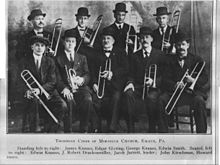This article needs attention from an expert in Music. The specific problem is: references and style. (October 2019) |

The Moravian musical tradition in United States began with the earliest Moravian settlers in the first half of the 18th century.
These Moravians were members of a well-established church – officially called Unitas Fratrum or Unity of Brethren – that by [the mid-18th century] had already seen almost three centuries of rich experience of religious life. They were spiritual descendants of the Czech priest Jan Hus, who for his attempts at reform was martyred in 1415. Forty-two years later in 1457, some of his followers founded a church body consecrated to following Christ in simplicity and dedicated living.
This newly constituted church developed a rich and orderly ecclesiastical life in the 15th and 16th centuries, but in the Thirty Years War of 1618-48 it was virtually wiped out. In the 1720s a few exiles of this religious heritage, along with various other seekers after truth, found refuge on an estate of a Saxon nobleman named Nicholaus Ludwig von Zinzendorf. There in their village of Herrnhut the ancient church experienced a rebirth culminating in a spiritual blessing on August 13, 1727, in which their former diversity of purpose was welded into one.
In a brief five years, by 1732, that first little village of the Renewed Moravian Church began sending missionaries to all corners of the world. After establishing work in England, the Moravians sent colonists to America in 1735. The initial settlement in Georgia proved unsuccessful, partly because of war between Protestant England and Catholic Spain to the south in Florida. More permanent work was established in Pennsylvania in 1741, with the town of Bethlehem as their chief center. Other settlements in Pennsylvania followed. The Moravians purchased 100,000 acres (400 km²) in North Carolina and settled at Bethabara in 1753 with the central town of Salem being founded in 1766.” [Villages of the Lord]